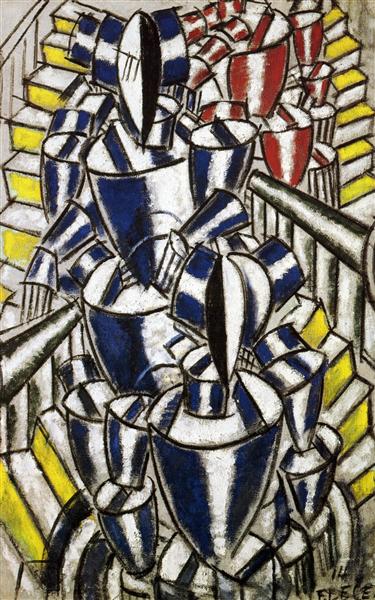1909 - 1920
Tubism

description
Tubism was an art movement within Cubism, it was the author’s style of Fernand Léger.
The term was coined by art critic Louis Voxel in 1911 to ironically describe the works of Fernand Léger.
It is based on the artistic principles of Cubism, the compositions are dominated by streamlined geometric forms – tubes in the form of cylinders with different, most often, in size bases, with stripes along; compositions are abstract. The compositional space of the paintings is completely filled with tubes that resemble nuts and bolts scattered on the floor. The predominant pure colors are white, blue, red, less often yellow, green. The main plot is figurative. The influence of technical progress can be traced in tubism. The characters in the paintings look like plastic dolls of a primitive shape, the images resemble knightly armor or cylindrical beads with a thread threaded.
Key paintings:
Geometric standarts. 1913. Fernand Leger.
The staircase. 1913. Fernand Leger.
July 14. 1914. Fernand Léger.
description
A French painter, sculptor, master of the monumental decorative art, one of the grandees of the fine art of the early twentieth century.The father of the future artist was engaged in cattle breeding and died when Fernan was only a few years old. Leger received his primary education at the church school in Tensecheb, and afterward, he studied architecture in Cannes.Fernand Leger played an important role in the formation and dissemination of Cubism and laid the foundations for such avant-garde trends as Neoplasticism and Constructivism. The artist actively collaborated with Cubist group "Golden Section", participated in the exhibitions "Salon of Independent", "Autumn Salon" and avant-garde association "Style", founded by Piet Mondrian in the Netherlands and the Russian "Jack of Diamonds". His interest in the possibility of synthesis of the arts led to the development and implementation of several architectural and design projects. The artist also clearly manifested himself in the field of applied creativity, scenography, cinema and book graphics. Together with Ozenfant, he founded The Free Art School, and later The Contemporary Art Academy. From 1940, the artist lived in the United States, where he taught at Yale University and at Mills College in California and achieved much in promoting contemporary art trends in the country.
1881 - 1955
